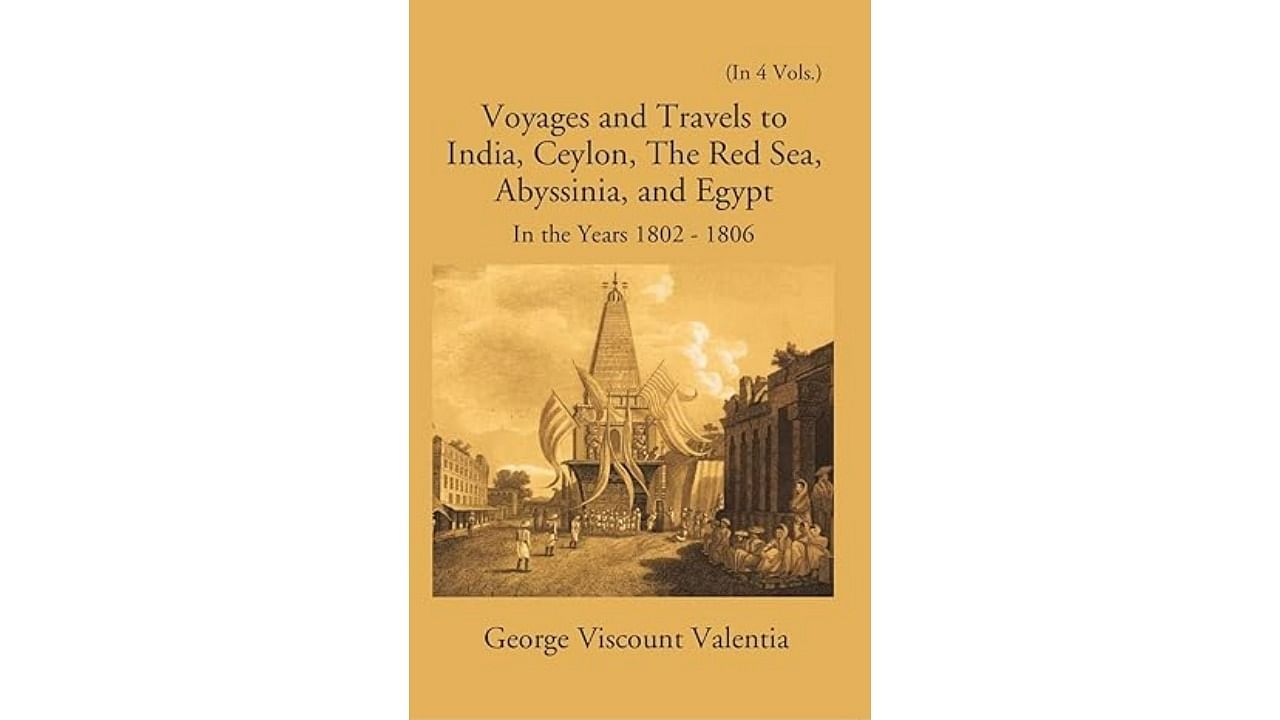
The travelogue written by George Viscount Valentia; the author (top). Photo courtesy:Wikimedia Commons
Mysore state was created because of the geographical interests of the English in the 19th Century. After the fourth Anglo-Mysore War in 1799, a small geographical territory was carved out of Tipu Sultan’s dominion. Later, its administrative responsibility was handed over to the representative of the Wadiyar dynasty.
The Maharaja then was Krishnaraja Wadiyar III. Since he was a minor, the administration and power were vested in the hands of Purnaiah, who was both the Dewan and the Regent.
During this time, particularly during the first half of the 19th century, many visitors came and travelled across Mysore. There were fortune seekers, missionaries and compilers of statistics — both official and personal. Their aim was to visit and explore the land recently acquired by the English and collect first-hand information about the land and the people. Among them, Valentia’s narratives proved to be of significance.
George Annesley, also known as George Viscount Valentia was a British Earl, whose accounts were published in 1811 in London. There were four volumes published under the title, ‘Voyages and Travels to India, Ceylon, the Red Sea, Abyssinia and Egypt in the years 1802, 1803, 1804, 1805 and 1806’. In the first volume, we get information about his visit to Mysore state. He was accompanied by Henry Salt, who rendered his service both as his secretary and draftsman.
Valentia left London, on 3 June, 1802. After visiting St Helena, South Africa and the Nicobar Islands, he reached Calcutta and passed through Bhagalpur and Banaras. After leaving Madras through on a palanquin, he entered the Mysore state.
Journey through Mysore
Here, he first visited Kolar and later, travelled to Bangalore. He visited both the ‘Pete and Kote’ areas, (the pettah and fort) which were then the geographical divisions in Bangalore. William Lambton, the surveyor commissioned by the East India Company was stationed here, and met Valentia. By this time, the Company had started surveying newly acquired geographical regions. Valentia expressed his desire to accompany the surveyor in his work. Later, after passing through Kengeri (where tigers roamed frequently), and Ramgiri, he passed Maddur and reached Srirangapatna.
By this time, Srirangapatna was slowly acquiring importance as a place where the arch enemy of the English had been killed. Here, he met several officials. Army officer Major Symons served as Valentia’s interpreter. He also met several civil and material officials and collected first-hand information.
He was led around the city in a procession which consisted of elephants, kettle-drums, trumpets and carriers of royal insignia. At his request, a meeting with the young Maharaja was planned. And accordingly, he continued his journey towards Mysore.
Mysore was gradually acquiring its importance of being a capital under the new regime. But it still remained as a small town. Valentia gives us information about a palace (probably a wooden structure) which was surrounded by houses. It was the same palace in which the coronation of the young Maharaja had taken place.
At Mysore, a procession was arranged, where a profusion of fruit, pastries and other dishes were served for dinner. Valentia provides us with details about this meeting with the Maharaja. The Maharaja, who was dressed in gold tissue with pearls around his neck, was seated on a ‘musnad’ (throne) made of ivory carved intricately and placed in the verandah. Valentia observes: “He is about eleven years old, of middle size neither tall nor short of his age; not handsome, but of an intelligent countenance. He seemed lively.”
Valentia received presents from the Maharaja which included beautiful chowries, punkhas, walking sticks made of sandalwood and bottles of oil. He presented the Maharaja with a sword. The traveller also met the young Maharaja’s mother and conversed with her with the help of an interpreter. As per the custom, there was a purdah in between them.
He returned to Srirangapatna and visited many bungalows, including the palace of the erstwhile Sultan. He also visited the great bridge, the construction of which was still in progress. After spending a day there, he proceeded towards Canara.